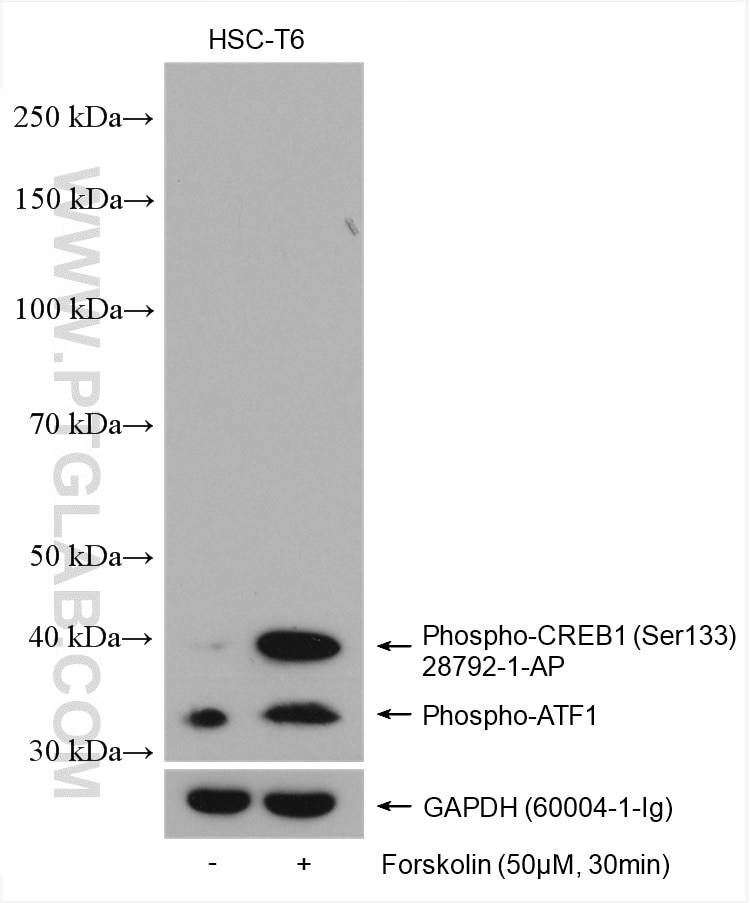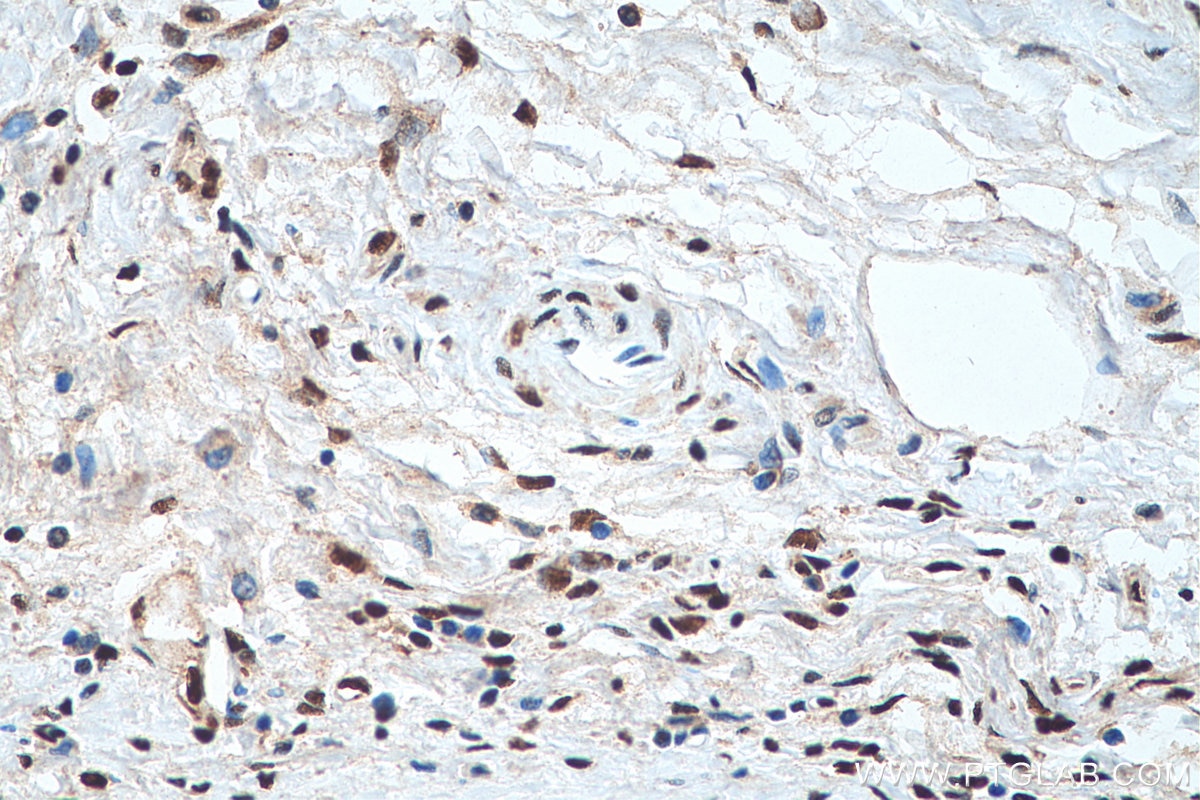Anticorps Polyclonal de lapin anti-Phospho-CREB1 (Ser133)
Phospho-CREB1 (Ser133) Polyclonal Antibody for IHC, WB, ELISA
Hôte / Isotype
Lapin / IgG
Réactivité testée
Humain, rat et plus (1)
Applications
WB, IHC, IF, ELISA
Conjugaison
Non conjugué
N° de cat : 28792-1-AP
Synonymes
Galerie de données de validation
Applications testées
| Résultats positifs en WB | cellules HSC-T6 traitées à la forskoline, |
| Résultats positifs en IHC | tissu hépatique humain, il est suggéré de démasquer l'antigène avec un tampon de TE buffer pH 9.0; (*) À défaut, 'le démasquage de l'antigène peut être 'effectué avec un tampon citrate pH 6,0. |
Dilution recommandée
| Application | Dilution |
|---|---|
| Western Blot (WB) | WB : 1:1000-1:8000 |
| Immunohistochimie (IHC) | IHC : 1:50-1:500 |
| It is recommended that this reagent should be titrated in each testing system to obtain optimal results. | |
| Sample-dependent, check data in validation data gallery | |
Applications publiées
| WB | See 14 publications below |
| IF | See 1 publications below |
Informations sur le produit
28792-1-AP cible Phospho-CREB1 (Ser133) dans les applications de WB, IHC, IF, ELISA et montre une réactivité avec des échantillons Humain, rat
| Réactivité | Humain, rat |
| Réactivité citée | rat, Humain, souris |
| Hôte / Isotype | Lapin / IgG |
| Clonalité | Polyclonal |
| Type | Anticorps |
| Immunogène | Peptide |
| Nom complet | cAMP responsive element binding protein 1 |
| Masse moléculaire calculée | 341 aa, 35 kDa |
| Poids moléculaire observé | 35-46 kDa |
| Numéro d’acquisition GenBank | BC010636 |
| Symbole du gène | CREB1 |
| Identification du gène (NCBI) | 1385 |
| Conjugaison | Non conjugué |
| Forme | Liquide |
| Méthode de purification | Purification par affinité contre l'antigène |
| Tampon de stockage | PBS avec azoture de sodium à 0,02 % et glycérol à 50 % pH 7,3 |
| Conditions de stockage | Stocker à -20°C. Stable pendant un an après l'expédition. L'aliquotage n'est pas nécessaire pour le stockage à -20oC Les 20ul contiennent 0,1% de BSA. |
Informations générales
The cAMP-response element binding protein (CREB) is localized in the nucleus and acts as a transcription factor, which binds to the cAMP response element (CRE) of the promoters of its target genes, upon phosphorylation at Ser133 by different receptor-activated protein kinases, such as protein kinase A (PKA), calmodulin-dependent protein kinase (CaMK), mitogen-activated protein kinases (MAPK), and other kinases. The activity of CREB1 in neurons has been correlated with various intracellular processes, including proliferation, differentiation, survival, long-term synaptic potentiation, neurogenesis, and neuronal plasticity. CREB1 belongs to the CREB/activating transcription factor (ATF) family of transcription factors. The antibody also detects the phosphorylated form of the CREB-related protein ATF1. (PMID: 30214393, PMID: 33917483, PMID: 32605164)
Protocole
| Product Specific Protocols | |
|---|---|
| WB protocol for Phospho-CREB1 (Ser133) antibody 28792-1-AP | Download protocol |
| IHC protocol for Phospho-CREB1 (Ser133) antibody 28792-1-AP | Download protocol |
| Standard Protocols | |
|---|---|
| Click here to view our Standard Protocols |
Publications
| Species | Application | Title |
|---|---|---|
J Ethnopharmacol Yangjing Zhongyu decoction facilitates mitochondrial activity, estrogenesis, and energy metabolism in H2O2-induced human granulosa cell line KGN. | ||
Brain Res Bull Metabotropic glutamate receptor 5 upregulation of γ-aminobutyric acid transporter 3 expression ameliorates cognitive impairment after traumatic brain injury in mice. | ||
Int J Mol Sci Downregulation of IL-8 and IL-10 by the Activation of Ca2+-Activated K+ Channel KCa3.1 in THP-1-Derived M2 Macrophages | ||
Redox Biol PM2.5 increases susceptibility to acute exacerbation of COPD via NOX4/Nrf2 redox imbalance-mediated mitophagy | ||
Exp Cell Res Dopamine D1 receptor activation ameliorates ox-LDL-induced endothelial cell senescence via CREB/Nrf2 pathway | ||
Front Pharmacol The Chinese herbal medicine Dai-Zong-Fang promotes browning of white adipocytes in vivo and in vitro by activating PKA pathway to ameliorate obesity |



